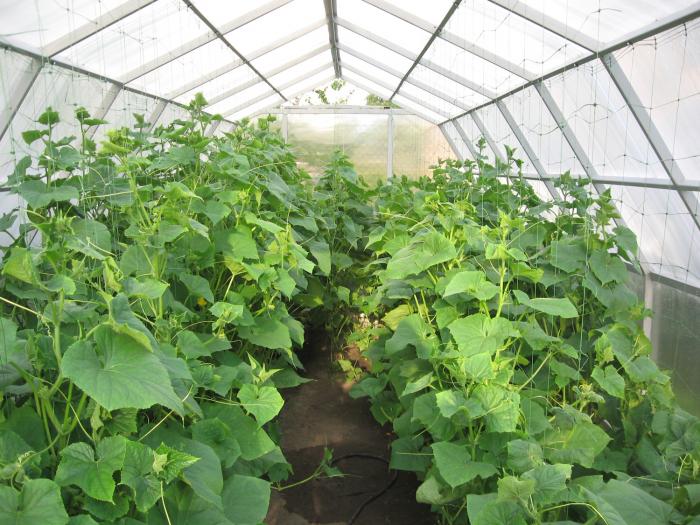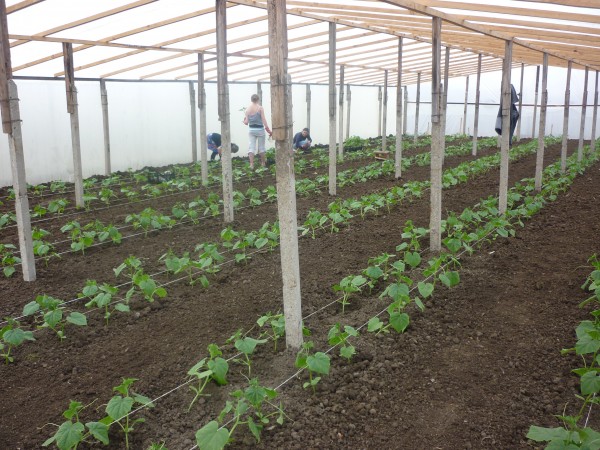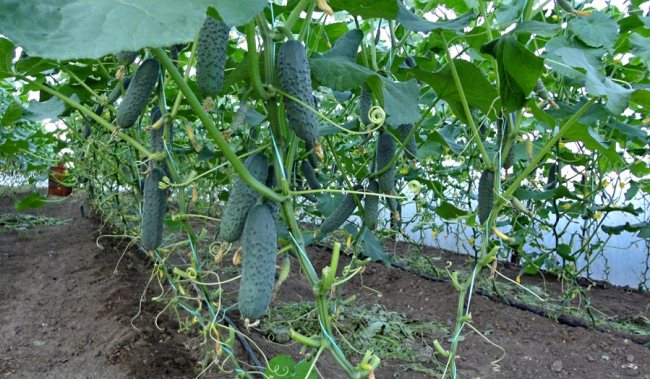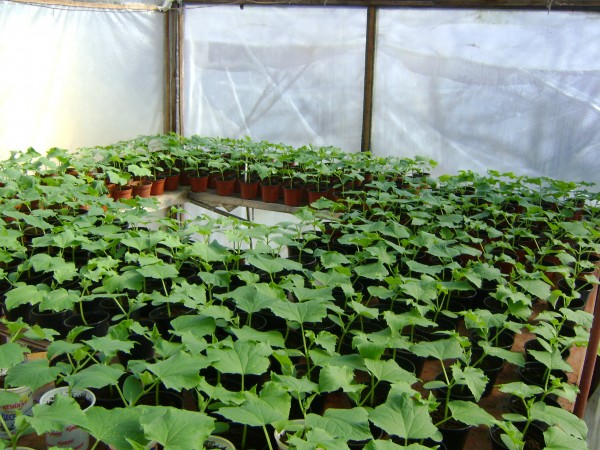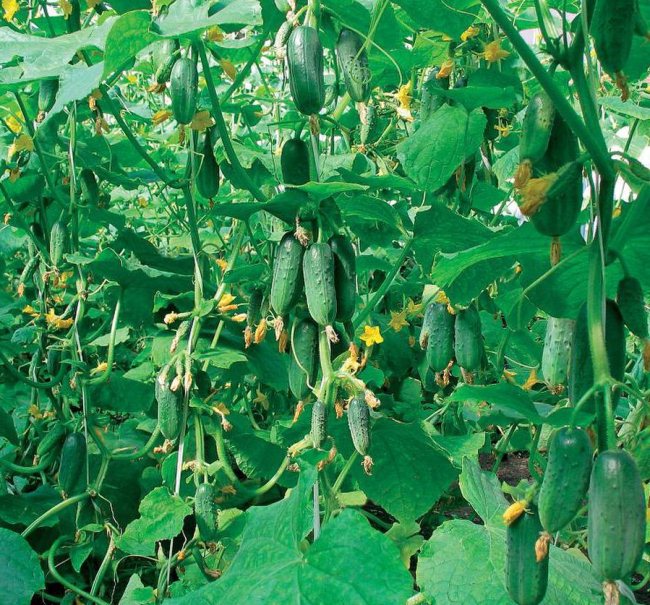Rules for planting cucumbers in a greenhouse: diagram, distance
Since most regions in terms of climatic conditions are not favorable for good development and growth in the open field of most heat-loving crops, it is increasingly practiced among amateur gardeners and farmers to plant cucumbers in a greenhouse. This ensures a high, quality and guaranteed yield. It is not at all difficult to equip a small film greenhouse in a summer cottage. However, you should know and take into account certain nuances, such as the scheme for planting cucumbers and further care for the plants.
Content
What should be the soil
Before planting cucumbers, it is necessary to determine the area on which the greenhouse will be located and prepare the soil in advance. To do this, they dig it deeply, remove the roots of perennial plants and at least 5-7 cm of the upper layer of the soil, since pathogens and viruses of various diseases that can infect young plants accumulate in it. After harvesting plant residues, it is possible to decontaminate the soil with the help of a 7% solution of copper sulfate. The soil must be necessarily enriched and fertile, with good absorption and carrying capacity, neutral or low acidity.
The soil mixture is prepared 20-30 days after the processing of the site. As practice has shown, it is better to plant cucumbers in a substrate of sod soil and fresh humus. For its preparation, 45-55% peat, 25-35% humus or compost, 15-25% fertile soil and 10-15% wood sawdust scalded with boiling water are used. 10-15 g of superphosphate and urea, 250-280 g of sifted ash, nitrogen fertilizers are not applied to a bucket of such a soil mixture.
When growing cucumber in greenhouse conditions, only the seedling method is used. Since this plant does not tolerate transplanting well, so as not to waste time on adaptation and survival, it is advisable to sow seeds for seedlings immediately in peat cups, pots or bags. It is recommended to plant seedlings 25-27 days old with 4-5 leaves. The time for planting it varies depending on the region, size and type of greenhouse.
Landing scheme
The most optimal conditions for fruit growth is provided by a two-line scheme for planting cucumbers in a greenhouse on the ridges and ridges, measuring 95-110 cm wide and 22-28 cm high. To increase yields, steam beds or ridges are used. To do this, dig holes with a depth of 35-45 cm.A layer of hot manure is laid on the bottom and covered with soil 14-18 cm thick.
Depending on the width of the greenhouse, the ridges are placed along or across. If its width is 2-2.5 m, then a path is made in the center, and one row is planted on the left and right. If the width of the greenhouse is 3.5-4.5 m, 2 lanes and 4-5 rows of planting are made, placing one on the sides and 2-3 in the center. The distance between the bushes in a row is 35-40 cm, since with a thicker planting, the illumination of the plant significantly worsens. Wire trellises are pulled over the ridges, to which cucumbers are subsequently tied with a thread or twine. Sometimes lettuce, Chinese cabbage or low-growing greens are planted in the aisles.
As soon as the weather is warm and the soil and soil warms up enough, seedlings can be planted. Immediately before planting, the prepared wells are watered with a warm solution of potassium permanganate, and then just with water. Cucumbers from pots are planted in such a way that the earthen lump remains 1.5-2.5 cm above the soil level.The root collar should not touch the soil, since water flowing down during irrigation and pathogens can provoke infection and death of the plant.
What cucumbers to plant?
Today there are a very large number of hybrids and varieties specially designed for growing in greenhouse conditions. They are characterized by high and stable fruiting, compactness of bushes, resistance to major diseases. When choosing a variety, preference should be given not only to high-yielding varieties with low lighting requirements, but to self-pollinated cucumbers that do not need pinching.
Some of the most popular are late-ripening, high-yielding hybrids White Angel F1, Athlete F1, Hercules F1. They are resistant to many diseases and pests. Fruits are medium large, weighing 160-190 g, with high taste, versatile in processing. However, they require artificial pollination, or planting a number of pollinator varieties. For this, the high-yielding hybrid Emelya F1 is often used.
Especially popular are such mid-season varieties as Relay, Iva, Moskovsky hothouse, Regatta, Spotresisting and hybrids Annushka F1, Dynamite F1, Pyzhik F1. They are self-pollinated, not demanding to care for. Fruits are medium, weighing 100-125 g, with a good watery-sweet taste, firm, crunchy.
Care features
Just like the cucumber grown in the open field, greenhouse plants require feeding, timely watering and the formation of a bush.
Bush formation
In greenhouse conditions, the cucumber is formed into one stem. 5-7 days after planting, the seedlings are tied to the installed trellis. As it grows, through each internode, the plant stem is twisted around the twine. When the stem outgrows the trellis, pinch the top. The lower sinuses are dazzling - they remove male and female flowers, as well as lateral shoots. Since the lower ovaries grow very slowly, they often do not ripen and inhibit the vegetative growth of the entire bush, drawing off nutrients. The next 4-6 branches are formed at the bottom of the stem. Pinch over the first leaf, leaving no more than 1-2 fruits for each shoot. Shoots, in the middle of the stem, are pinched over the second leaf.
Then they only make sure that the branches do not go beyond the aisles. To do this, pinch their tops as necessary and direct them into the ridge. If bee-pollinated varieties are grown in the greenhouse, then insects should be provided with access to plants. It should be borne in mind that in hot, summer time, bees are reluctant to fly into the greenhouse. As a rule, they are lured with sugar syrup, which is infused with the corolla of male flowers.
Scheme of planting a cucumber in a greenhouse
Watering
The soil must always be kept moist, waterlogging or waterlogging is not allowed. Disastrous for planting and a sharp fluctuation in moisture, this can provoke not only root rot, deformation of fruits, death of leaves and dropping of ovaries, but also the death of the entire plant.
In early spring, in relatively cold weather, cucumbers are watered only with warm water, regardless of the time of day. In hot weather, watering is preferably carried out in the morning, consuming 5-8 liters of water for each square meter. To accelerate fruiting, short-term weak drying of the soil is used at the end of flowering. Since the film does not allow water vapor to pass through, it is necessary to ventilate the greenhouse daily, avoiding air stagnation. To prevent the soil from compaction, it is advisable to loosen it shallowly after each watering. And as the roots appear on the surface, add fresh nutrient mixture with a layer of 1.5-2 cm.
Top dressing
As a fertilizer, an infusion of chicken manure, mullein, humus and rotted foliage is used. Cucumbers do not tolerate a high concentration of soil solution. Therefore, 150-200 g of organic matter is added to a bucket of water.Leave for 1-2 days for the contents to ferment, then adding 150-250 g of wood ash and 30-50 g of superphosphate. From mineral fertilizers, preparations are used for pumpkin crops. Throughout the season, cucumbers are fed no more than 4-5 times.
It should be noted that the excess of organic and mineral substances also negatively affects the yield. Plants begin to fatten, grow vigorously, and budding and flowering are delayed.
Video "Planting cucumbers in the greenhouse"
This video tells how to plant seedlings so as not to damage the roots, how to feed the plants for maximum yield.

